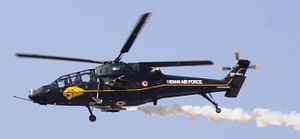India’s Light Combat Helicopter (LCH), currently under development by Hindustan Aeronautics Limited (HAL) for service in the Indian Army (IA) and Indian Air Force (IAF) is undergoing weapons integration, according to local media reports.
“LCH is ready, we are integrating its weapons, we tried rockets and it was good, we need to try missiles ATGM — anti-tank guided missile, (these) are the ones which we are integrating and we just have to demonstrate that,” the chairman of HAL, Suvarnu Raja told The Times of India.
HAL has so far been extensively testing four LCH prototypes. The third LCH helicopter recently completed hot and high altitude trials at Leh in Jammu and Kashmir. The LCH prototypes have been undergoing extensive weapons trials beginning in July, as I reported elsewhere (See: “India’s Light Combat Helicopter to Start Weapons Trials”).
A LCH prototype also successfully fired 70 millimeter rockets during the 2016 iteration of the IAF’s Iron Fist military exercise held in March in the Thar Desert in Pokhran, Rajasthan in northwestern India. “The flight trials were successful with respect to system integration, structural integrity, noise and vibration, functionality of system and safe separation of rockets,” Indian Minister of State for Defense Rao Inderjit Singh told the Indian Parliament in May, in reference to the helicopter’s performance during Iron Fist.
The LCH is armed with a number of different weapons systems, as I explained in an earlier piece:
The armored attack helicopter’s weapon suite includes a 20 millimeter French Giat-Nexter turret gun, four Belgium-made 70 mm anti-tank guided missiles (or, once operational, the Indian Helina anti-tank missile, which is still in development), and MBDA Mistral-2 air-to-air missiles. SAAB South Africa is providing the LCH’s electronic warfare suite.
Speaking to the Times of India, Raja also revealed that HAL is undertaking limited serial production of the LCH. “We have launched a limited series production, with a confidence and hope that we get definite orders on this. We have also inquiries on this platform from other countries, and so we will start making five helicopters this year,” Raju said.
The Indian Army’s Army Aviation Corps (AAC) has expressed its intention of acquiring 114 helicopters and the IAF 65. However, no contract has been signed so far. “It has to turn into a contract between the Services and HAL,” according to Raju.
As I reported previously (See: “What’s the Status of India’s Light Combat Helicopter?”), the history of the LCH project goes back to the lack of an adequate light helicopter gunship during the 1999 Kargil War:
The LCH, which made its maiden flight in May 2010, has been specifically developed in response to the lack of an attack helicopter capable of performing high-altitude operations during the 1999 Kargil War. Consequently, the LCH, a derivative of the HAL Dhruv helicopter, has been primarily designed for high-altitude warfare – HAL and French engine-maker, Turbomeca jointly designed a special engine optimized for extreme altitudes – and has an operational ceiling limit of 6,000–6,500 meters (19,700–21,300 feet).
The AAC helicopter fleet is only at 70 percent of its authorized strengths, according to the Indian Ministry of Defense.
































